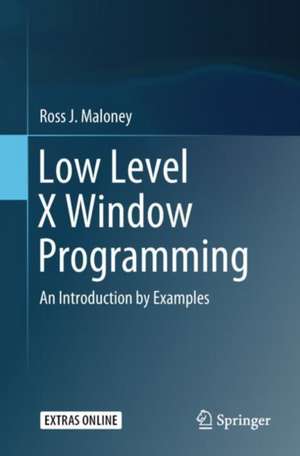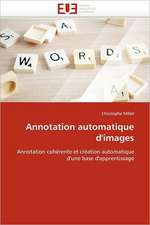Low Level X Window Programming: An Introduction by Examples
Autor Ross J. Maloneyen Limba Engleză Paperback – 13 apr 2018
The majority of the book covers Xlib, although a short coverage of Xcb is also given. Included are:
. The relationship between Xlib and the X Window protocol;
. All the basic Xlib topics are covered;
. Complete working programs with their results;
. Exercises to reinforce the material just covered.
A 9 part partition to building a complete X program is used throughout. This partitioning fosters the inclusion of all code necessary. All programs are written in C and are one to four pages in length. Open source programs with the occasional Postscript script are shown to provide support as needed. Throughout the examples consideration is given to using colour. The examples produce simple results with the aim of providing building blocks for application oriented codes. The book is directed at graduate students and researchers who create computer code to visualise their data.
Preț: 392.13 lei
Preț vechi: 490.17 lei
-20% Nou
Puncte Express: 588
Preț estimativ în valută:
75.05€ • 78.06$ • 62.89£
75.05€ • 78.06$ • 62.89£
Carte tipărită la comandă
Livrare economică 10-15 martie
Preluare comenzi: 021 569.72.76
Specificații
ISBN-13: 9783319742496
ISBN-10: 3319742493
Pagini: 268
Ilustrații: XII, 264 p. 77 illus., 32 illus. in color.
Dimensiuni: 155 x 235 x 18 mm
Greutate: 0.47 kg
Ediția:1st ed. 2017
Editura: Springer International Publishing
Colecția Springer
Locul publicării:Cham, Switzerland
ISBN-10: 3319742493
Pagini: 268
Ilustrații: XII, 264 p. 77 illus., 32 illus. in color.
Dimensiuni: 155 x 235 x 18 mm
Greutate: 0.47 kg
Ediția:1st ed. 2017
Editura: Springer International Publishing
Colecția Springer
Locul publicării:Cham, Switzerland
Cuprins
Preliminaries.- Getting Something to Show.- Windows and Events Produce Menus.- Pattern Maps and Labels.- Keyboard Entry and Displaying Text.- Classic Drawing.- Extensions.- The Xcb Alternative.- Closer to the X Protocol.
Notă biografică
Ross Maloney has been around computers for over 50 years. He has worked with log tables, slide rules, hand calculators, mainframes, mini computers, micro computers, to today's workstations. He holds bachelors and master degrees in engineering and mathematics from UWA and WAIT, and a PhD in computing science from Murdoch University. For over two decades he worked in government but is now in private practice. He has tutored and lectured undergraduates in computer science over a 10 year period. His current research interests are in application of visualisation and parallel processing to text documents and applied physical science.
Textul de pe ultima copertă
This is the missing X Window book. While others have shown what the X Window system has available, this book shows how to convert this potential into working tools to fulfil your visualisation needs. It is of the show-me class of books.
The majority of the book covers Xlib, although a short coverage of Xcb is also given. Included are:
The book is directed at graduate students and researchers who create computer code to visualise their data.
The majority of the book covers Xlib, although a short coverage of Xcb is also given. Included are:
- The relationship between Xlib and the X Window protocol;
- All the basic Xlib topics are covered;
- Complete working programs with their results;
- Exercises to reinforce the material just covered.
The book is directed at graduate students and researchers who create computer code to visualise their data.
Caracteristici
The generally thought difficult programming in Xlib and Xcb is introduced in a comprehensive manner from program start to finish This book develops guidelines using small demonstration programs which are adaptable to real-world data visualisation coding This is one of the first books to cover Xlib for doing the whole job, as opposed to it being mentioned in passing while proceeding to perceived better solutions The book addresses the question: Can low level X Window programming provide an alternative to tool kits in achieving visualisation goals?

















